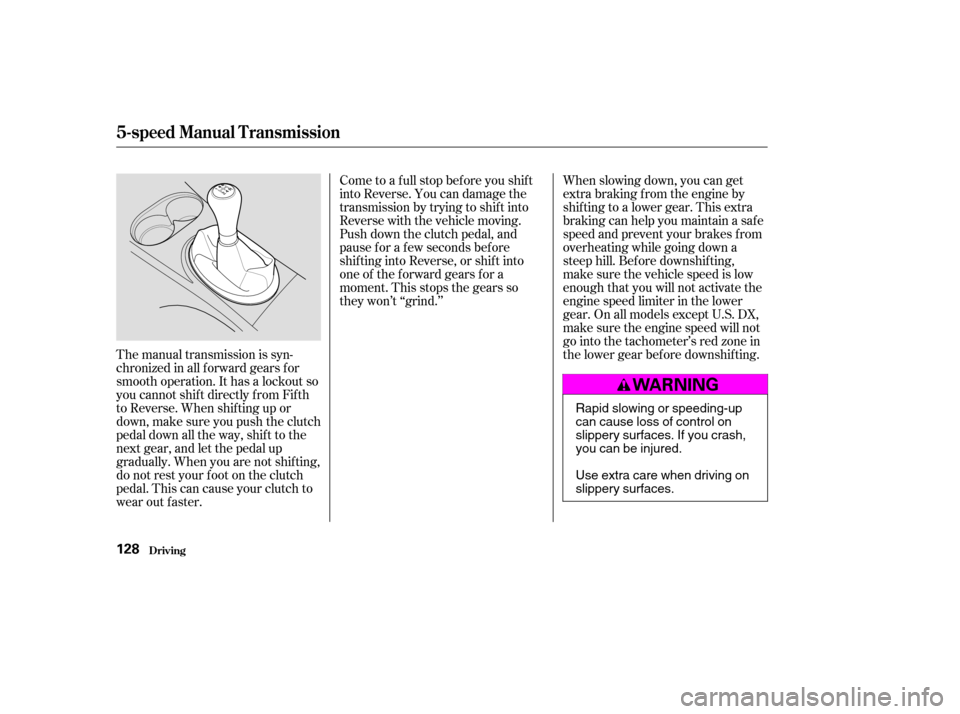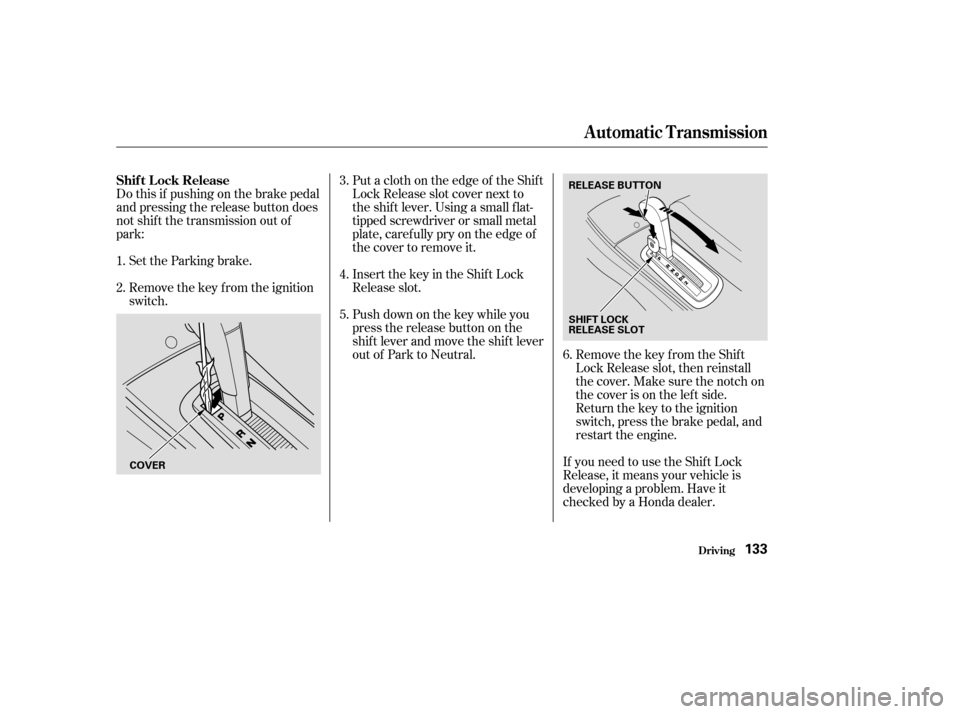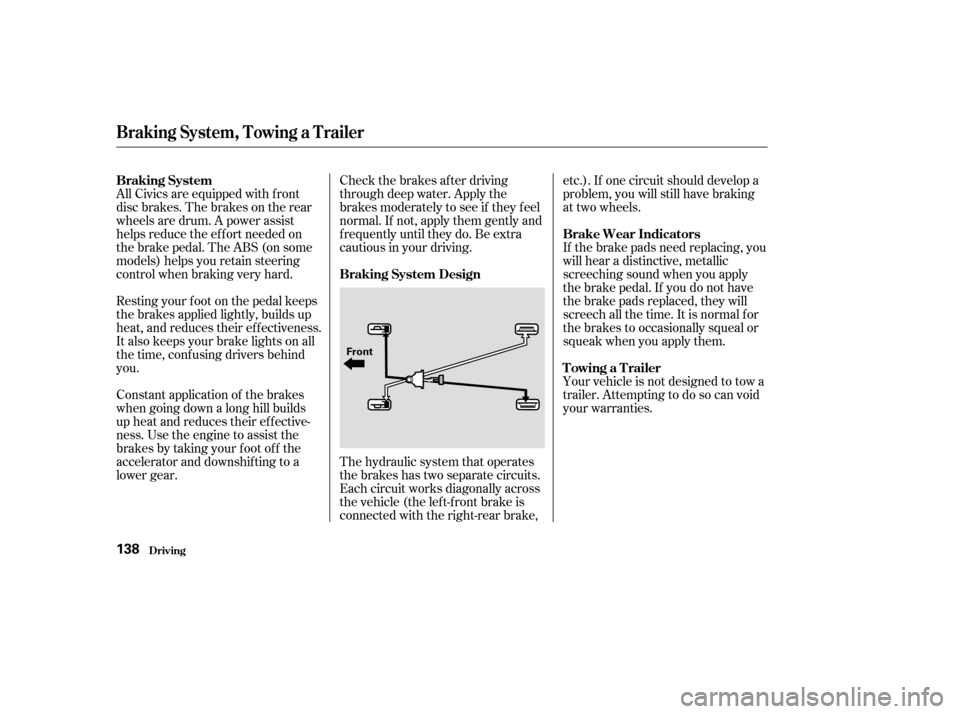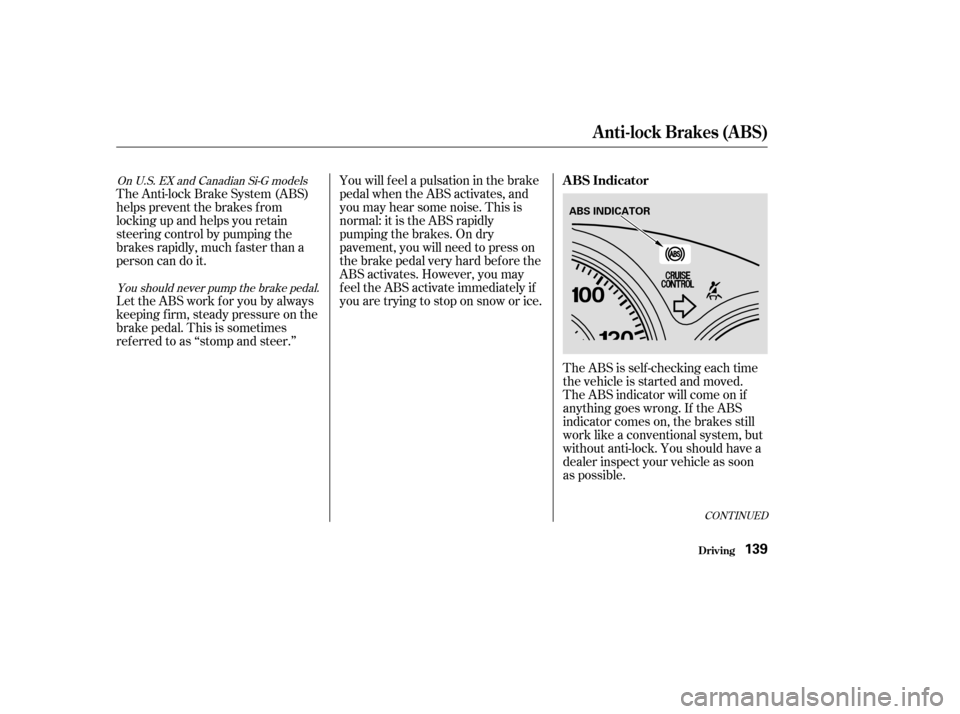Page 127 of 231

The manual transmission is syn-
chronizedinallforwardgearsfor
smooth operation. It has a lockout so
you cannot shift directly from Fifth
to Reverse. When shif ting up or
down,makesureyoupushtheclutch
pedal down all the way, shift to the
next gear, and let the pedal up
gradually. When you are not shif ting,
do not rest your f oot on the clutch
pedal. This can cause your clutch to
wear out faster.Come to a full stop before you shift
into Reverse. You can damage the
transmission by trying to shif t into
Reverse with the vehicle moving.
Push down the clutch pedal, and
pause f or a f ew seconds bef ore
shif ting into Reverse, or shif t into
one of the f orward gears f or a
moment. This stops the gears so
they won’t ‘‘grind.’’
When slowing down, you can get
extra braking from the engine by
shifting to a lower gear. This extra
braking can help you maintain a safe
speed and prevent your brakes f rom
overheating while going down a
steep hill. Bef ore downshif ting,
make sure the vehicle speed is low
enough that you will not activate the
engine speed limiter in the lower
gear. On all models except U.S. DX,
make sure the engine speed will not
go into the tachometer’s red zone in
the lower gear bef ore downshif ting.
5-speed Manual T ransmission
Driving128
Rapid slowing or speeding-up
can cause loss of control on
slippery surfaces. If you crash,
you can be injured.
Use extra care when driving on
slippery surfaces.
�����—�����—�����y�
�������������y���
�(���%�������y���
���
�y
Page 129 of 231
These indicators on the instrument
panel show which position the shif t
lever is in.To shif t f rom any position, press
f irmly on the brake pedal and press
the release button on the front of the
shiftlever.Youcannotshiftoutof
Park when the ignition switch is in
LOCK (0) or ACCESSORY (I).
The ‘‘D’’ indicator comes on f or a
f ew seconds when you turn the
ignition switch to ON (II). If it
f lashes while driving (in any shif t
position), it indicates a possible
problem in the transmission. Avoid
rapid acceleration and have the trans-
mission checked by a Honda dealer
as soon as possible.
Automatic Transmission
Shif t L ever Position Indicators
Shif ting
Driving130
U.S.: LX, EX, Canada: LX, Si RELEASE BUTTONSHIFT LEVER
Canada: DX
U.S.: DX
�����—�����—�����y�
���������
���y���
�(���%�������y���
�����y
Page 130 of 231

�µ
�µ �µ
�µ
�µ
To shift from: PtoR
RtoP
NtoR
Dto2
2toD
DtoD DtoN
DtoD NtoDRtoN Do this:
Press the brake pedal and
press the release button.
Press the release button.
Move the lever.
3
3
3 3
3
3
To avoid transmission damage, come
to a complete stop bef ore shif ting
into Park. The shif t lever must be in
Park bef ore you can remove the key
from the ignition switch. Press the brake
pedal and press the release button to
the f ront of shif t lever to shif t f rom
Park to Reverse. To shif t f rom
Reverse to Neutral, come to a
completestopandthenshift.
Use Neutral if you
need to restart a stalled engine, or if
it is necessary to stop brief ly with
the engine idling. Shif t to the Park
position if you need to leave your
vehicle for any reason. Press on the
brake pedal when you are moving
the shift lever from Neutral to
another gear. Use this position f or
your normal driving. The transmis-
sion automatically selects a suitable
gear f or your speed and acceleration.
You may notice the transmission
shif ting up at higher speeds when
the engine is cold. This helps the
engine warm up f aster.
This position is similar
to D, except only the first three
gears are selected. Use D to provide
engine braking when going down a
steep hill. D can also keep the
transmission f rom cycling between
third and f ourth gears in stop-and-go
driving.
This position mechani-
cally locks the transmission. Use
Park whenever you are turning of f or
starting the engine. To shif t out of
Park, you must press on the brake
pedal and have your f oot of f the
accelerator pedal.
If you have done all of the above and
still cannot move the lever out of
Park, see on
page . 133
CONT INUED
Reverse (R)
Neutral (N) Drive (D)
Drive (D )
Park (P)
Shif t L ock Release
3
Automatic Transmission
Driving131
�����—�����—�����y�
�������������y���
�(���%�������y���
�����y
Page 132 of 231

Do this if pushing on the brake pedal
and pressing the release button does
not shif t the transmission out of
park:Put a cloth on the edge of the Shif t
Lock Release slot cover next to
the shif t lever. Using a small f lat-
tipped screwdriver or small metal
plate, caref ully pry on the edge of
the cover to remove it.
Remove the key from the Shift
Lock Release slot, then reinstall
thecover.Makesurethenotchon
the cover is on the lef t side.
Return the key to the ignition
switch, press the brake pedal, and
restart the engine.
Insert the key in the Shift Lock
Release slot.
Push down on the key while you
pressthereleasebuttononthe
shif t lever and move the shif t lever
out of Park to Neutral.
If you need to use the Shif t Lock
Release, it means your vehicle is
developing a problem. Have it
checked by a Honda dealer.
Set the Parking brake.
Remove the key from the ignition
switch.
1. 2. 3. 4. 5.
6.
Automatic Transmission
Driving
Shif t L ock Release
133
COVER SHIFT LOCK
RELEASE SLOT
RELEASE BUTTON
�����—�����—�����y�
�������������y���
�(���%�������y���
�����y
Page 134 of 231

�µ
�µ �µTo shift from:
PtoR
RtoP
NtoR StoL
LtoS
StoD
DtoS
DtoN
NtoD RtoN Do this:
Press the brake pedal and
press the release button.
Press the release button.
Move the lever.To shift from Re-
verse to Park, see the explanation
under Park. To shif t to Reverse f rom
Neutral, come to a complete stop
first. Press the release button before
shifting into Reverse from Neutral.
This position mechani-
cally locks the transmission. Use
Park whenever you are turning of f or
starting the engine. To shif t out of
Park, you must press on the brake
pedal and have your f oot of f the
accelerator pedal.
If you have done all of the above and
still cannot move the lever out of
Park, see on
page . To avoid transmission damage, come
to a complete stop bef ore shif ting
into Park. The shif t lever must be in
Park bef ore you can remove the key
from the ignition switch.
Use Neutral if you
need to restart a stalled engine, or if
it is necessary to stop brief ly with
the engine idling. Shif t to the Park
position if you need to leave your
vehicle for any reason. Press on the
brake pedal when you are moving
the shift lever from Neutral to
another gear.
133
CONT INUED
Automatic Transmission (CVT)
Driving
Reverse (R)
Park (P) Shif t L ock Release Neutral (N)
135
�����—�����—�����y�
�������������y���
�(���%�������y���
�����y
Page 136 of 231

Always use the parking brake when
you park your vehicle. Make sure
the parking brake is set f irmly or
your vehicle may roll if it is on an
incline.Make sure the moonroof and the
windows are closed.
Turn of f the lights.
Place any packages, valuables, etc.
in the trunk or take them with you.
Lock the doors.
If your vehicle has an automatic
transmission, set the parking brake
bef ore you put the transmission in
Park. This keeps the vehicle f rom
moving and putting pressure on the
parking mechanism in the
transmission.
Never park over dry leaves, tall
grass, or other f lammable
materials. The hot three way
catalytic converter could cause
these materials to catch on fire.If the vehicle is f acing uphill, turn
the f ront wheels away f rom the
curb. If you have a manual
transmission, put it in f irst gear.
If the vehicle is f acing downhill,
turn the front wheels toward the
curb. If you have a manual
transmission, put it in reverse gear.
Make sure the parking brake is
f ully released bef ore driving away.
Driving with the parking brake
partially set can overheat or
damage the rear brakes.
Driving
Parking T ips
Parking
137
�����—�����—�����y�
�������������y���
�(���%�������y���
�����y
Page 137 of 231

Check the brakes after driving
through deep water. Apply the
brakes moderately to see if they f eel
normal. If not, apply them gently and
f requently until they do. Be extra
cautious in your driving.
All Civics are equipped with f ront
disc brakes. The brakes on the rear
wheels are drum. A power assist
helps reduce the ef f ort needed on
thebrakepedal.TheABS(onsome
models) helps you retain steering
control when braking very hard.
Resting your f oot on the pedal keeps
the brakes applied lightly, builds up
heat, and reduces their ef f ectiveness.
It also keeps your brake lights on all
the time, conf using drivers behind
you.
Constant application of the brakes
when going down a long hill builds
up heat and reduces their ef f ective-
ness. Use the engine to assist the
brakes by taking your f oot of f the
accelerator and downshif ting to a
lower gear.
The hydraulic system that operates
the brakes has two separate circuits.
Each circuit works diagonally across
the vehicle (the lef t-f ront brake is
connected with the right-rear brake,etc.). If one circuit should develop a
problem, you will still have braking
at two wheels.
If the brake pads need replacing, you
will hear a distinctive, metallic
screeching sound when you apply
the brake pedal. If you do not have
the brake pads replaced, they will
screech all the time. It is normal f or
the brakes to occasionally squeal or
squeak when you apply them.
Your vehicle is not designed to tow a
trailer. Attempting to do so can void
your warranties.
Braking System, Towing a Trailer
Driving
Braking System Design
Braking System
Brake Wear Indicators
Towing a Trailer
138
Front
�����—�����—�����y�
�������������y���
�(���%�������y���
���
�y
Page 138 of 231

The ABS is self -checking each time
the vehicle is started and moved.
The ABS indicator will come on if
anything goes wrong. If the ABS
indicator comes on, the brakes still
work like a conventional system, but
without anti-lock. You should have a
dealer inspect your vehicle as soon
as possible.
You will f eel a pulsation in the brake
pedal when the ABS activates, and
you may hear some noise. This is
normal: it is the ABS rapidly
pumpingthebrakes.Ondry
pavement, you will need to press on
thebrakepedalveryhardbeforethe
ABS activates. However, you may
feel the ABS activate immediately if
you are trying to stop on snow or ice.
The Anti-lock Brake System (ABS)
helps prevent the brakes f rom
locking up and helps you retain
steering control by pumping the
brakes rapidly, much f aster than a
person can do it.
Let the ABS work f or you by always
keeping f irm, steady pressure on the
brake pedal. This is sometimes
ref erred to as ‘‘stomp and steer.’’
CONT INUED
You should never pump the brake pedal.
On U.S. EX and Canadian Si-G models
Anti-lock Brakes (ABS)
Driving
ABS Indicator
139
ABS INDICATOR
�����—�����—�����y�
�������������y���
�(���%�������y���
�����y